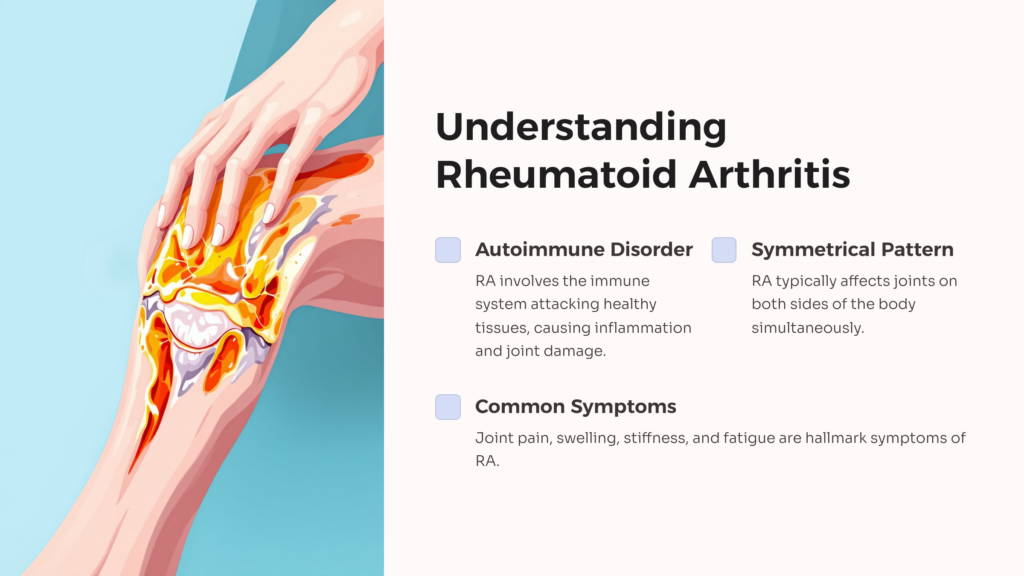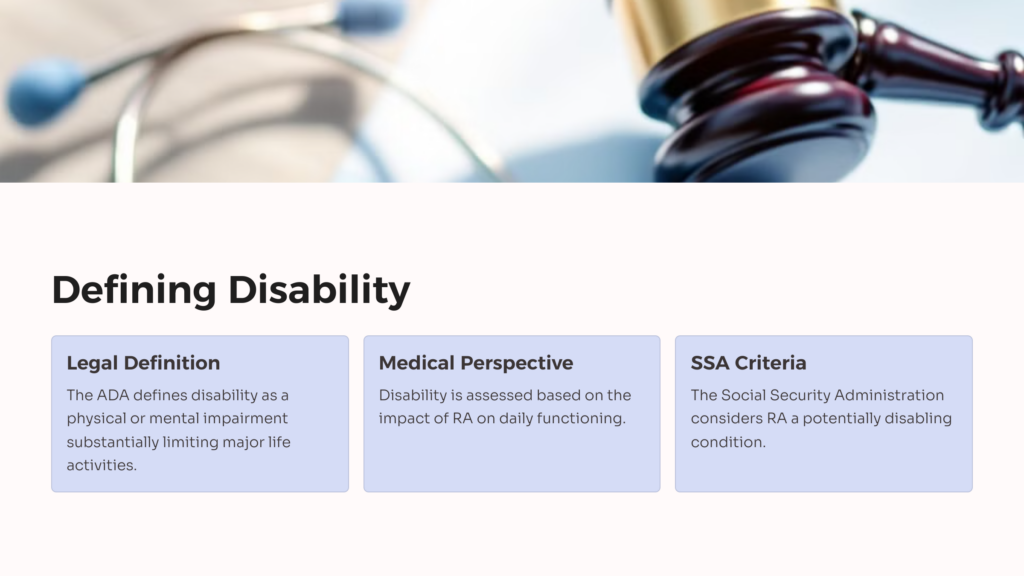Joint pain is just one of the symptoms of rheumatoid arthritis that can make it challenging to perform job tasks such as gripping and grasping items or using repetitive motions.
If you’re dealing with rheumatoid arthritis (RA), you might wonder if it counts as a disability.
Generally, If you’re unable to work due to arthritis, you may qualify for monthly disability benefits under the Social Security Administration (SSA).
This article will discuss how the SSA defines rheumatoid arthritis, when it qualifies for benefits, and how to apply for disability benefits if your condition meets SSA criteria.
Understanding Rheumatoid Arthritis

Rheumatoid arthritis (RA) is a chronic autoimmune disorder that affects millions of people worldwide.
Unlike osteoarthritis, which primarily targets the joints through wear and tear, RA involves the immune system mistakenly attacking healthy tissues, leading to inflammation and joint damage.
One of the defining characteristics of RA is its symmetrical pattern of joint involvement, meaning it typically affects joints on both sides of the body simultaneously. Common symptoms include joint pain, swelling, stiffness, and fatigue, which can vary in severity and fluctuate over time.
Morning stiffness lasting more than an hour is a hallmark feature of RA, often improving with movement as the day progresses.
As RA progresses, it can lead to joint deformities, loss of function, and systemic complications affecting various organs, such as the heart, lungs, and eyes. The inflammation associated with RA can also result in complications like rheumatoid nodules, which are firm lumps that form under the skin, and inflammation of blood vessels (vasculitis).
Impact on Daily Life
Living with RA can present numerous challenges that extend beyond physical symptoms. The unpredictable nature of the condition can disrupt daily routines and activities, making it difficult to work, engage in hobbies, or perform simple tasks.
Fatigue, another common symptom of RA, can further exacerbate these difficulties, leaving individuals feeling drained and unable to participate fully in their usual activities.
Furthermore, the chronic pain and limitations imposed by RA can have a significant impact on mental health and emotional well-being.
Coping with the physical limitations and the uncertainty of living with a chronic condition can lead to feelings of frustration, anxiety, and depression.
Defining Disability

Rheumatoid arthritis is one of the disabling impairments listed in the Social Security Administration (SSA) Blue Book. However, your medical condition must affect your ability to work to be eligible for benefits.
According to SSA, you may qualify for social security disability if your arthritic pain made you quit your job.
In the legal world, disability is often defined within legislation such as the Americans with Disabilities Act (ADA) in the United States. These laws typically define disability as a physical or mental impairment substantially limiting one or more major life activities, such as walking, seeing, hearing, or working.
Under the ADA, individuals with disabilities are protected from discrimination in various aspects of public life, including employment, transportation, and access to public facilities and services. The ADA also requires employers and other entities to provide reasonable accommodations to enable individuals with disabilities to perform essential job functions or access services.
From a medical perspective, disability is often assessed based on the impact of a condition on an individual’s ability to function in daily life.
In the case of rheumatoid arthritis, disability assessments may consider factors such as joint pain, stiffness, fatigue, and limitations in mobility and physical functioning.
These assessments aim to gauge the severity of the condition and its impact on an individual’s ability to perform activities of daily living, work-related tasks, and other essential functions.
Rheumatoid Arthritis and Disability
Rheumatoid arthritis can significantly impair your ability to engage in daily activities and maintain employment due to symptoms such as joint pain, stiffness, and fatigue. The unpredictable nature of RA flares and disease progression can further complicate management and impact overall functioning.
If you have rheumatoid arthritis, seeking disability designation may involve documenting the extent of impairment and its interference with essential life activities. This documentation may include medical records, assessments of functional limitations, and evidence of attempts to manage symptoms through treatment and accommodations.
Navigating Disability Designation
The process of obtaining disability designation for rheumatoid arthritis can be complex and challenging. It usually requires thorough documentation of medical history, symptoms, treatment plans, and functional limitations.
Understanding the definitions and criteria for disability designation is crucial for individuals with rheumatoid arthritis. By navigating the legal and medical frameworks surrounding disability, individuals can access necessary support, accommodations, and protections to enhance their quality of life and participation in society.
Whether seeking accommodations in the workplace or applying for disability benefits, clarity on disability definitions is essential for advocating for the rights and needs of individuals with rheumatoid arthritis and other disabling conditions.
Legal Framework
In the United States, Americans with Disabilities Act (ADA) safeguard the rights of individuals with disabilities, including those grappling with conditions like rheumatoid arthritis (RA). Understanding the implications of the ADA is paramount if you’re seeking disability accommodations and benefits.
ADA: Protection and Accommodations
Enacted in 1990, the ADA prohibits discrimination against individuals with disabilities in employment, public accommodations, transportation, and government services.
Under the ADA, rheumatoid arthritis is recognized as a qualifying disability, provided it substantially limits one or more major life activities, such as walking, standing, lifting, or performing manual tasks.
Employers covered by the ADA must provide reasonable accommodations to enable individuals with disabilities to perform essential job functions unless such accommodations impose undue hardship on the employer.
Accommodations for individuals with rheumatoid arthritis may include ergonomic workstations, flexible scheduling, modified duties, or assistive devices to mitigate the impact of symptoms on job performance.
Reasonable Accommodations and Interactive Process
The ADA emphasizes the importance of engaging in an interactive process between employers and employees to identify and implement reasonable accommodations tailored to the individual’s needs.
This collaborative approach allows for exploring accommodations that effectively address the functional limitations imposed by rheumatoid arthritis while maintaining productivity and job satisfaction.
Public Accommodations and Access
Beyond the workplace, the ADA ensures that individuals with disabilities have equal access to public accommodations and services, including restaurants, stores, theatres, and medical facilities.
This extends to provisions for accessible parking, ramps, designated seating areas, and auxiliary aids and services, ensuring that individuals with rheumatoid arthritis can navigate public spaces and participate fully in community life.
Medical Assessment and Diagnosis
Diagnosing rheumatoid arthritis (RA) and evaluating its impact on an individual’s ability to function involves medical assessment, diagnostic criteria, and functional evaluation.
The diagnosis of rheumatoid arthritis typically begins with a comprehensive medical history and physical examination by a healthcare provider, often a rheumatologist specializing in autoimmune disorders. Key components of the medical history include:
- The onset and duration of symptoms.
- Family history of autoimmune diseases.
- Any factors that may exacerbate or alleviate symptoms.
During the physical examination, the healthcare provider assesses joint tenderness, swelling, warmth, and range of motion, focusing on the number and distribution of affected joints. Laboratory tests, such as blood tests for inflammatory markers (e.g., C-reactive protein, erythrocyte sedimentation rate) and rheumatoid factor or anti-cyclic citrullinated peptide (anti-CCP) antibodies, may aid in confirming the diagnosis and assessing disease activity.
Established criteria, such as the 2010 American College of Rheumatology/European League Against Rheumatism (ACR/EULAR) classification criteria, guide the diagnosis of rheumatoid arthritis (RA).
These criteria incorporate clinical, laboratory, and imaging findings to differentiate RA from other forms of arthritis and autoimmune conditions.
Key components of the ACR/EULAR criteria include the presence of joint involvement, duration of symptoms, serologic markers (e.g., rheumatoid factor, anti-CCP antibodies), acute-phase reactants (e.g., C-reactive protein), and evidence of synovitis on imaging studies (e.g., ultrasound or magnetic resonance imaging). Meeting specific thresholds for these criteria helps establish the diagnosis of rheumatoid arthritis.
Functional Limitations and Impacts of Rheumatoid Arthritis
Living with rheumatoid arthritis (RA) presents several challenges that extend beyond physical symptoms that profoundly impact daily life and work capacity.
Mobility Issues
One of the hallmark features of rheumatoid arthritis is joint inflammation and stiffness, which can severely impair mobility and range of motion. Individuals with RA often experience difficulty walking, climbing stairs, or performing activities that require bending or reaching.
Chronic Pain
Chronic pain is a pervasive symptom of rheumatoid arthritis, stemming from inflammation and joint damage. The persistent pain associated with RA can vary in intensity and location, affecting multiple joints throughout the body. This ongoing discomfort can significantly diminish quality of life, disrupt sleep patterns, and contribute to fatigue and mood disturbances.
Managing chronic pain often requires a multifaceted approach, combining medication, physical therapy, lifestyle modifications, and coping strategies to alleviate symptoms and improve functioning.
Fatigue and Energy Depletion
Fatigue is a prevalent and debilitating symptom of rheumatoid arthritis, often disproportionate to physical activity levels and unrelieved by rest. The relentless cycle of pain, inflammation, and sleep disturbances associated with RA can drain energy reserves and leave individuals feeling exhausted and depleted.
Fatigue can impact productivity, concentration, and emotional well-being, making it challenging to maintain employment, engage in social activities, or pursue hobbies and interests.
Impact on Work Capacity
The functional limitations of rheumatoid arthritis can affect employment and work capacity. Individuals with RA may need help to meet the physical demands of their jobs, leading to decreased productivity, absenteeism, or difficulty maintaining employment.
Accommodations such as ergonomic workstations, flexible scheduling, modified duties, or telecommuting arrangements may be necessary to enable individuals with RA to continue working and remain engaged in the workforce.
Navigating Disability Benefits

Before applying for disability benefits, you must understand the eligibility criteria established by the Social Security Administration (SSA) in the United States. To qualify for Social Security Disability Insurance (SSDI) or Supplemental Security Income (SSI) benefits or even the VA benefits, individuals with rheumatoid arthritis must demonstrate that their condition meets specific criteria related to medical severity and functional limitations.
Gather Medical Documentation
Documentation plays a crucial role in the disability benefits application process. You should gather comprehensive medical records documenting the diagnosis, treatment history, and functional limitations associated with your condition.
This may include clinical notes from healthcare providers, imaging studies (e.g., X-rays, MRIs), laboratory results, and functional assessments conducted by medical professionals.
Complete the Application
The disability benefits application process typically begins by completing an application form provided by the disability determination agency. You must provide detailed information about your medical condition, work history, income, and daily activities. Be sure to provide accurate and thorough information to ensure a comprehensive eligibility evaluation.
Submit Supporting Evidence
You should submit supporting evidence, such as medical records and documentation of functional limitations, in addition to the application form.
This evidence helps substantiate the severity of the condition and its impact on daily life and work capacity.
Providing detailed and relevant documentation can strengthen the disability claim and improve the likelihood of approval.
Follow Up on Application Status
After submitting the disability benefits application, following up regularly on its status and any requests for additional information or documentation is important. Disability determination agencies may require additional clarification or evidence to assess eligibility fully. Staying informed and proactive throughout the process can help expedite the review and decision-making process.
Social Security Disability Insurance (SSDI) vs. Supplemental Security Income (SSI)
When it comes to disability compensation, the Social Security Administration (SSA) offers two primary programs in the United States: Social Security Disability Insurance (SSDI) and Supplemental Security Income (SSI). While both programs provide financial assistance to individuals with disabilities like RA, they differ in eligibility criteria, funding sources, and benefit amounts.
Social Security Disability Insurance (SSDI)
SSDI is a program designed to benefit individuals who have worked and paid into the Social Security system through payroll taxes. To qualify for SSDI benefits, applicants must meet the following criteria:
Work Credits: Applicants must have accumulated sufficient work credits based on their employment history and payment of Social Security taxes. The number of work credits required depends on the individual’s age at the time of disability onset.
Disability Status: Applicants must have a qualifying disability that meets the SSA’s definition of disability, which includes a severe impairment expected to last for at least 12 months or result in death. The disability must prevent the individual from engaging in substantial gainful activity (SGA).
SSDI benefits are calculated based on the individual’s average lifetime earnings covered by Social Security taxes. These benefits are not subject to income or asset limits, and eligibility is not based on financial need.
Supplemental Security Income (SSI):
SSI is a needs-based program that provides financial assistance to individuals with disabilities who have limited income and resources. To qualify for SSI benefits, applicants must meet the following criteria:
Disability Status: Applicants must have a qualifying disability that meets the SSA’s definition of disability, similar to the criteria for SSDI.
Income and Resource Limits: SSI eligibility is based on financial need, and the SSA sets strict income and resource limits. Income includes earnings from work and other sources such as pensions, unemployment benefits, and family support. Resources include cash, bank accounts, stocks, and property.
SSI benefits are calculated based on the federal benefit rate (FBR) set annually by the SSA. In addition to the federal benefit, some states may supplement SSI payments with additional funds.
Workplace Accommodations and Rights
Coping at the workplace with a disability, such as Rheumatoid Arthritis (RA), requires awareness of legal protections and avenues for securing accommodations.
Workplace accommodations are modifications or adjustments to enable individuals with disabilities to perform essential job functions. For individuals with RA, accommodations may include:
Flexible Work Schedule: Adjusting work hours or allowing telecommuting to accommodate fluctuations in symptoms and fatigue.
Ergonomic Workstation: Providing ergonomic furniture, such as adjustable desks and chairs, to minimize joint strain and discomfort.
Assistive Devices: Providing assistive devices such as voice recognition software, ergonomic keyboards, or adaptive tools to facilitate tasks requiring manual dexterity.
Job Restructuring: Modifying job duties or redistributing tasks to accommodate mobility or physical functioning limitations.
Legal Rights under the ADA
The Americans with Disabilities Act (ADA) prohibits discrimination against individuals with disabilities in all aspects of employment, including recruitment, hiring, training, promotions, and termination. Under the ADA, employers must provide reasonable accommodations to qualified individuals with disabilities unless doing so would impose undue hardship on the business.
Key provisions of the ADA relevant to workplace accommodations include:
Reasonable Accommodations: Employers must interact with employees to identify and implement reasonable accommodations that enable individuals with disabilities to perform essential job functions.
Equal Opportunity: Individuals with disabilities must have equal access to employment opportunities, benefits, and privileges offered by the employer without discrimination based on disability.
Confidentiality: Employers must maintain confidentiality regarding an employee’s disability status and any accommodations provided, except as necessary for workplace safety or compliance with legal requirements.
Prohibition of Retaliation: Employers are prohibited from retaliating against individuals with disabilities who assert their rights under the ADA, such as requesting accommodations or filing complaints of discrimination.
Advocating for Your Rights:
Empowering individuals with disabilities to advocate for their rights in the workplace involves:
Financial Assistance Programs

Beyond Social Security Disability Insurance (SSDI) and Supplemental Security Income (SSI), there exist additional financial assistance programs designed to support individuals grappling with disabilities, including rheumatoid arthritis (RA).
State-Specific Programs:
Many states offer supplementary programs to assist individuals with disabilities, providing additional financial support and services beyond federal benefits. These programs may include:
State Disability Assistance: Some states offer disability assistance programs to supplement federal benefits, providing financial aid and services to individuals with disabilities who do not qualify for SSDI or SSI.
Medicaid Waivers: Medicaid waiver programs offer home and community-based services to individuals with disabilities, including personal care assistance, transportation, and respite care. Eligibility criteria and services vary by state.
Housing Assistance: State housing agencies may offer rental assistance, housing vouchers, or subsidized housing programs for individuals with disabilities facing housing insecurity.
Vocational Rehabilitation: State vocational rehabilitation agencies provide job training, employment services, and assistive technology to individuals with disabilities seeking to enter or re-enter the workforce.
Nonprofit Organizations
Numerous nonprofit organizations and advocacy groups focus on supporting individuals with rheumatoid arthritis and other disabilities, offering financial assistance, educational resources, and advocacy efforts. Some notable organizations include:
Arthritis Foundation: The Arthritis Foundation provides support and resources for individuals with arthritis, including educational materials, community programs, and financial assistance for medical expenses and treatments.
National Organization for Rare Disorders (NORD): NORD offers financial assistance programs for individuals with rare diseases, including some forms of inflammatory arthritis. These programs may provide grants to cover medical expenses, travel costs, or other necessities.
Patient Advocate Foundation: The Patient Advocate Foundation offers financial assistance and advocacy services for individuals facing chronic and life-threatening illnesses, including rheumatoid arthritis. Assistance may include help with insurance appeals, copayment assistance, and access to treatment.
Disability Rights Organizations: Various disability rights organizations, such as the Disability Rights Education and Defense Fund (DREDF) and the National Disability Rights Network (NDRN), advocate for the rights of individuals with disabilities and offer resources on legal protections, advocacy strategies, and access to benefits.
Embracing Life with Rheumatoid Arthritis
Living with rheumatoid arthritis (RA) can present numerous challenges, but with resilience, determination, and support, individuals can embrace life to the fullest despite the obstacles.
Prioritize Self-Care: Investing in self-care is crucial for managing RA symptoms and maintaining overall well-being. Prioritize activities that promote physical and emotional health, such as gentle exercise, proper nutrition, adequate rest, stress management techniques, and relaxation practices.
Establish a Strong Support System: Surround yourself with a supportive network of family, friends, healthcare providers, and peers who understand your challenges and offer encouragement, empathy, and practical assistance when needed. Joining support groups or online communities for individuals with RA can provide valuable camaraderie and shared experiences.
Seek Professional Guidance: Work closely with your healthcare team, including rheumatologists, physical therapists, occupational therapists, and mental health professionals, to develop a comprehensive treatment plan tailored to your unique needs.
Final Thoughts- Stay Informed and Empowered
Stay informed about advancements in RA treatments, self-management strategies, and available support services.
As you continue your journey, remember that support and resources are available. For further assistance, guidance, and community connection, visit AllVeteran, where you can find additional information, support services, and a community of individuals navigating similar challenges.
 AllVeteran.com Advisors
AllVeteran.com Advisors
With expertise spanning local, state, and federal benefit programs, our team is dedicated to guiding individuals towards the perfect program tailored to their unique circumstances.











